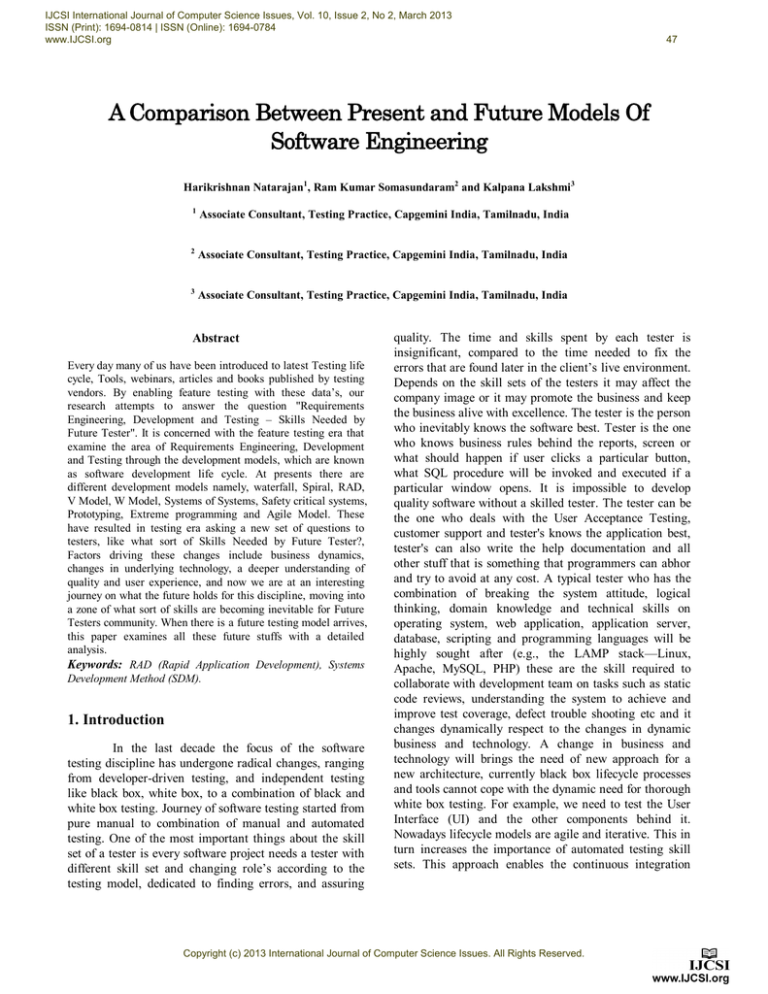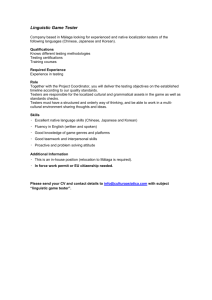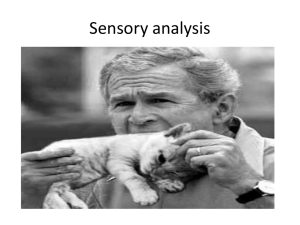
IJCSI International Journal of Computer Science Issues, Vol. 10, Issue 2, No 2, March 2013
ISSN (Print): 1694-0814 | ISSN (Online): 1694-0784
www.IJCSI.org
47
A Comparison Between Present and Future Models Of
Software Engineering
Harikrishnan Natarajan1, Ram Kumar Somasundaram2 and Kalpana Lakshmi3
1
Associate Consultant, Testing Practice, Capgemini India, Tamilnadu, India
2
Associate Consultant, Testing Practice, Capgemini India, Tamilnadu, India
3
Associate Consultant, Testing Practice, Capgemini India, Tamilnadu, India
Abstract
Every day many of us have been introduced to latest Testing life
cycle, Tools, webinars, articles and books published by testing
vendors. By enabling feature testing with these data’s, our
research attempts to answer the question "Requirements
Engineering, Development and Testing – Skills Needed by
Future Tester". It is concerned with the feature testing era that
examine the area of Requirements Engineering, Development
and Testing through the development models, which are known
as software development life cycle. At presents there are
different development models namely, waterfall, Spiral, RAD,
V Model, W Model, Systems of Systems, Safety critical systems,
Prototyping, Extreme programming and Agile Model. These
have resulted in testing era asking a new set of questions to
testers, like what sort of Skills Needed by Future Tester?,
Factors driving these changes include business dynamics,
changes in underlying technology, a deeper understanding of
quality and user experience, and now we are at an interesting
journey on what the future holds for this discipline, moving into
a zone of what sort of skills are becoming inevitable for Future
Testers community. When there is a future testing model arrives,
this paper examines all these future stuffs with a detailed
analysis.
Keywords: RAD (Rapid Application Development), Systems
Development Method (SDM).
1. Introduction
In the last decade the focus of the software
testing discipline has undergone radical changes, ranging
from developer-driven testing, and independent testing
like black box, white box, to a combination of black and
white box testing. Journey of software testing started from
pure manual to combination of manual and automated
testing. One of the most important things about the skill
set of a tester is every software project needs a tester with
different skill set and changing role’s according to the
testing model, dedicated to finding errors, and assuring
quality. The time and skills spent by each tester is
insignificant, compared to the time needed to fix the
errors that are found later in the client’s live environment.
Depends on the skill sets of the testers it may affect the
company image or it may promote the business and keep
the business alive with excellence. The tester is the person
who inevitably knows the software best. Tester is the one
who knows business rules behind the reports, screen or
what should happen if user clicks a particular button,
what SQL procedure will be invoked and executed if a
particular window opens. It is impossible to develop
quality software without a skilled tester. The tester can be
the one who deals with the User Acceptance Testing,
customer support and tester's knows the application best,
tester's can also write the help documentation and all
other stuff that is something that programmers can abhor
and try to avoid at any cost. A typical tester who has the
combination of breaking the system attitude, logical
thinking, domain knowledge and technical skills on
operating system, web application, application server,
database, scripting and programming languages will be
highly sought after (e.g., the LAMP stack—Linux,
Apache, MySQL, PHP) these are the skill required to
collaborate with development team on tasks such as static
code reviews, understanding the system to achieve and
improve test coverage, defect trouble shooting etc and it
changes dynamically respect to the changes in dynamic
business and technology. A change in business and
technology will brings the need of new approach for a
new architecture, currently black box lifecycle processes
and tools cannot cope with the dynamic need for thorough
white box testing. For example, we need to test the User
Interface (UI) and the other components behind it.
Nowadays lifecycle models are agile and iterative. This in
turn increases the importance of automated testing skill
sets. This approach enables the continuous integration
Copyright (c) 2013 International Journal of Computer Science Issues. All Rights Reserved.
IJCSI International Journal of Computer Science Issues, Vol. 10, Issue 2, No 2, March 2013
ISSN (Print): 1694-0814 | ISSN (Online): 1694-0784
www.IJCSI.org
testing and it is impossible to work on manual testing and
classical tools.
Every project can be classified into four distinct
phases - Requirement management, Analysis and Design,
Development, Testing and Deployment & Production
Management. All these phases are managed by dedicated
teams and the focus areas for testers are Requirement,
Development and Testing phase. Now here, we are going
to closely focus on Requirement, Development, Testing
phase, Testing Process, Skill Stacks and the modern
approach to future testing. Lets us have a quick look at
some of the common challenges we have come across in
various models, while we are expecting a future testing,
over the recent past.
2. Modern Challenges in Historical
1.
2.
3.
4.
5.
6.
7.
Testing processes that span across different
systems create highly complex test data.
Heterogeneous technologies - Expensive to do
testing and managing a wide variety of systems.
Managing wide range of Peoples across the
geographies in disparate teams.
More reusability - More problems in security and
performance area.
Integrated Systems - More points of failure
results in more defects.
Multi layered and Mission complex architecture
makes it tough to isolate defects.
Agility - Enabling faster change leads to increase
in integration and regression testing
.
48
4. Different Models of Testing Life Cycle Changing Skills & Roles of Testers
Waterfall Model
The waterfall model is a sequential software
development process, in which progress is seen as flowing
steadily downwards (like a waterfall) [2] through the
phases of Conception, Initiation, Analysis, Design
(validation), Construction, Testing and maintenance [4].
Spiral Model
The spiral model is a software development
process combining elements of both design and
prototyping-in-stages, in an effort to combine advantages
of top-down and bottom-up concepts. [8] Also known as
the spiral lifecycle model, it is a systems development
method (SDM) used in information technology (IT) [1].
This model of development combines the features of the
prototyping model and the waterfall model.
RAD Model
RAD
represents
‘Rapid
Application
Development’. In order to implement a RAD development,
all of the requirements must be known in advance. But
with RAD the requirements are formally documented.
Each requirement is categorized into individual
components. Then each component is developed and
tested in parallel. All this is done in a set period of time.
RAD is considered to be an iterative development model.
3. Initial Steps of Testing Process
V Model
Every Software Project has 3 important phases Requirement, Development and Testing Phases. Software
testing Focus on three phases
The V-Model is an industry standard framework
that shows clearly the software development lifecycle in
relation to testing. [7] It also highlights the fact that the
testing is just as important as the software development
itself. The relationships between development and testing
are clearly defined. The V-Model improves the presence
of the testing activities to display a more balanced
approach [3].
Requirement Phase: The first step in the software testing
is validation of requirements.
Development Phase: We validate the development
process (this is synonymous with unit testing). This
validation of development process results in standard
software development
Testing Phase: The subsequent level of testing phase is
all about with system testing, integration testing and
regression testing to shield them from breaking changes.
W Model
The W-model further clarifies the priority of
tasks and dependence between the development and
testing activities. Though as simple as V-model, the Wmodel makes the importance of testing and ordering of
the individual testing activities clear. It also clarifies that
testing and debugging are not the same thing.
Copyright (c) 2013 International Journal of Computer Science Issues. All Rights Reserved.
IJCSI International Journal of Computer Science Issues, Vol. 10, Issue 2, No 2, March 2013
ISSN (Print): 1694-0814 | ISSN (Online): 1694-0784
www.IJCSI.org
Systems of Systems
A system of systems is a set of collaborating
components (including hardware, individual software
applications and communications), interconnected to
achieve a common purpose, without a unique
management structure.
Safety critical systems
Safety critical systems are those which, if their
operation is lost or degraded (e.g. as a result of incorrect
or inadvertent operation), can result in catastrophic or
critical consequences. The supplier of the safety critical
system may be liable for damage or compensation, and
testing activities are thus used to reduce that liability. The
testing activities provide evidence that the system was
adequately tested to avoid catastrophic or critical
consequences.
49
have web of component invocations and defect isolation,
allows you to have across technologies, example: UI
automation, middleware tests, DB querying and service
testing.
Methodology Changes
A new future model brings the need for a new
approach. Currently with historical lifecycle processes and
tools cannot cope with sudden need for deep testing. Tools
like HP's automation tools, IBM's tools and many other
open source tools pave a way to overcome the challenges
needs. But in future testing, depending upon the
methodology adapts to diverse system ecology and
virtually strong methodologies need to addresses the
governance ease of roadblocks implementation. Finally a
good future testing tools and modern tools will aid in
testing service and also help in defect isolation.
6. Discussion and Conclusion
Agile Model
Agile Software Development is a conceptual
framework for software development that promotes
development iterations throughout the life-cycle of the
project. Many different types of agile development
methods exist today, but most aim to minimize risk by
developing software in short amounts of time. Each
period of time is referred to as an iteration, which
typically lasts from one to four weeks. System was
adequately tested to avoid catastrophic or critical
consequences.
Future Model
Requirements will be more iterative passion,
development will be more iterative and more agility.
Hence testing will be more iterative and more agility. So
the future testers must have the knowledge of modern
tools and methodologies. The roles of tester’s are
increasingly important and crucial throughout the entire
lifecycle model.
5. Modern Tools and Methodology Changes
Modern Tool Requirements
Modern tools has a unique architectural design,
they can address testing in non- components, cope up with
subscriptions to brokers; can interpret messages that flow
across the complex system. Modern tools have its unique
protocols such a as SOAP, WS - Security and takes you to
The Future Tester's has to improve his
knowledge in new generation of testing models,
approaches and specialized modern testing tools. Future
Testers need to know modern testing tools, larger testing
processes, skill stacks and wider range of testing roles &
practices. These includes Testing Models, Business
changes, Technology trends, Test Data Management,
Automation,
Security,
Performance
and
deep
understanding of quality. Success in Future testing will
come to Quality Assurance organizations that leverage the
testers who have the ability in selecting the right tools and
supporting testing process. This move will ensure that the
future tester will deliver on the promises that meet the
business user's expectation. Such a tester will shine in
future Requirements Engineering, Development and
Testing.
References
[1]. Ian Sommerville, "Software Engineering", Addison Wesley,
7th edition, 2004.
[2]. CTG. MFA – 003, "A Survey of System Development
Process Models", Models for Action Project: Developing
Practical Approaches to Electronic Records Management
and Preservation, Center for Technology in Government
University at Albany / Suny, 1998.
[3]. Steve Easterbrook, "Software Lifecycles", University of
Toronto Department of Computer Science, 2001.
[4]. National Instruments Corporation, "Lifecycle Models",
2006, http://zone.ni.com.
[5]. JJ Kuhl, "Project Lifecycle Models: How They Differ and
When to Use them", 2002 www.businessesolutions.com.
[6]. Karlm, "Software Lifecycle Models', KTH, 2006.
Copyright (c) 2013 International Journal of Computer Science Issues. All Rights Reserved.
IJCSI International Journal of Computer Science Issues, Vol. 10, Issue 2, No 2, March 2013
ISSN (Print): 1694-0814 | ISSN (Online): 1694-0784
www.IJCSI.org
[7]. Rlewallen, "Software Development Life Cycle Models",
2005, http://codebeter.com.
[8]. Barry Boehm, "Spiral Development: Experience, Principles,
and Refinements", edited by Wilfred J. Hansen, 2000
[9]. A. comparison between five Models of Software
Engineering, September, 2010
Harikrishnan Natarajan Harikrishnan Natarajan is an Associate
Consultant at Capgemini India Pvt. Ltd. He started his career in 2009
and has extended his knowledge and expertise over the years by
working in banking areas (Core banking, Retail Banking) and roles
(Test Engineer, Test Analyst). He received a B.Tech Degree in
Information Technology and he is an ISTQB certified tester. His
current research includes Genetic Algorithm, Quality Management,
Process Improvement, Software Process Modeling, Software
Metrics, and Agile Software Development. He is a member of
Association of Computer Electronics and Electrical Engineers
(ACEEE).
Ram Kumar Somasundaram is an Associate Consultant at
Capgemini India Pvt. Ltd. He completed his B.Tech Information
Technology, in Tamilnadu College of Engineering. He has 3 + years of
experience in Manual Testing. Also He is an IIBF Certified. He has
been involved in the testing Credit Cards, Core banking. He is
currently engaged in research involving Testing Maturity Model and
Security based testing in Cloud computing.
Kalpana Lakshmi is an Associate Consultant at Capgemini India
Pvt. Ltd. she completed her MCA in C R Reddy College, Eluru,
Andhrapradesh. She has close to 4 years of experience in
Automation and Manual Testing. She has been involved in the testing
Banking Products. She is currently engaged in research involving
Testing Framework and Quality Management.
Copyright (c) 2013 International Journal of Computer Science Issues. All Rights Reserved.
50



